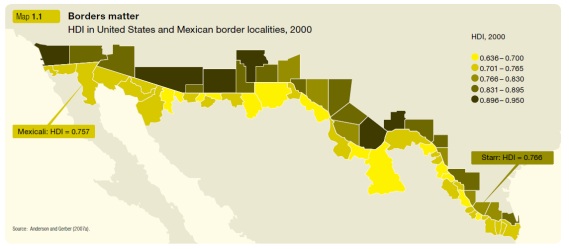Comparing Border Counties
Not surprisingly, there is a great deal of disparity in terms of development on the two sides of the US-Mexican border.
 The above graphic (which is from the 2009 Human Development Report, page 10) shows the disparity between development in US border counties as compared to their Mexican counterparts.
The above graphic (which is from the 2009 Human Development Report, page 10) shows the disparity between development in US border counties as compared to their Mexican counterparts.
The basis for comparison is the Human Development Index (HDI: see here for more info) which measures development on a scale from 0.0 to 1.0 (higher is better). What is interesting is that the lowest HDI county on the US side (Starr County Texas) is higher than the highest HDI municipality in Mexico (i.e., Mexicali).
This is, of course, likely not a shock to anyone paying even a modicum of attention to the situation. Still, it continues to underscore that fundamental aspect of this situation: it is the disparity of wealth between the two countries that continues to create the synergy of migration over the border. As I keep saying: any policy that ignores this fact will fail. As such, calls for massive deportations or that assumes it is possible to stop migration over the border is naught more than fantasy. “Seal the border!” is a slogan, not a viable policy.
The 2009 Report is interesting, as it looks at the question of global migration and has a host of stats that clearly explain the dynamic in question. For example:
a family who migrates from Nicaragua to Costa Rica increases the probability that their child will be enrolled in primary school by 22 percent (10).
The ability to improve the lives of oneself and one’s family is a huge incentive–and one that is difficult to legislate away.






So Steven, what you are saying is if my neighbor is richer than I am. I have some sort of right to invade his place and help myself to what he has. If you think sealing our borders is undoable, you never spent much time on this side of the iron curtain, up close. Let me tell you, that border was sealed. Double fence with a mine field in between would stop most of those invaders.
The combination of a continental border, much of which is sparsely populated, and a 1st World/3rd world juxtaposition is a virtual invitation. I can’t think of a current or historical situation that’s remotely comparable.
First, let me say that I do not favor trying to seal the border, and am a (naturalized) immigrant myself. However, in the spirit of intellectual honesty, is it really not possible to seal the border? I hear claims on both sides, but have yet to come across any actual reasoned discussion. When people say it is not possible, do they mean that it is not possible at any cost, or it is not politically feasible to fund it? If it is possible, but just at a very high price, are there actual, objective estimates of the cost? Or do they mean that it’s “not possible” because it would turn America into a police state that is antithetical to our ideals.
Note that even if it were possible at an affordable cost, I would not favor it. I’m just curious about the details here.
I think may be, in theory, possible to seal the border (although I suppose it depends on what “seal” means).
However, the cost, manpower required, and loss of legitimate transit would be so great that for all practical purposes, it is impossible.
As I’ve said before, I believe the best anti-immigration policy would be to improve the Mexican economy. I also don’t see any reason why immigrating to the US legally should take a decade and cost a small fortune. The quota system we use is based on 19th Century economics that really don’t apply today.
However, I’m really bothered when we have a legal policy that doesn’t square with our de facto policy. The best solution is to fix the legal policy, not ignore it.
Therefore, while it may not be possible to truly seal the border, it definitely is possible to do a better job than we’re doing today of policing the thing. The fact that I want to enforce the laws as written doesn’t mean I endorse those laws. But if a law is unworkable, let’s be honest about it and change the thing.
This is, fundamentally, my whole point in all of these discussions. As you note, we have a legal policy that doesn’t square with our de facto policy”–indeed, it doesn’t square with the obvious reality that has been staring us in the face for some time now.
Well, if we can’t secure the border then the other option is to make it untenable for illegals to reside or thrive in the interior. If only some state would attempt this?
But one thing for sure is that we shouldn’t be propping up or supporting the kleptocracy governments of Mexico and other suppliers of illegals. Better we should be pressuring them to open up their economies to promote growth. There was hope in the 1990s but then they blew up their currency.
But such a measure won’t be possible until we get rid of the current crop in Washington since their tactic is to destroy jobs in the US thus forcing out the illegals by default.
Well, okay, would it be possible at all to enforce at the place of work? I realize that much of this economy is cash-based, but just wondering if it would be possible at all.
“The ability to improve the lives of oneself and one’s family is a huge incentive–and one that is difficult to legislate away.”
You and me are on the same page here, Dr. Taylor. Living HERE is better than living THERE.
“Well, if we can’t secure the border then the other option is to make it untenable for illegals to reside or thrive in the interior. ”
If you can find a way to make it untenable for illegals without first making it untenable for citizens, sure that might work. But good luck with that.
<i>I think may be, in theory, possible to seal the border (although I suppose it depends on what “seal” means).
However, the cost, manpower required, and loss of legitimate transit would be so great that for all practical purposes, it is impossible.</i>
Similarly, it may may be possible to stop physical spousal abuse but the cost, intrusion on privacy, etc would be so great that it is impossible and therefore we should abandon all attempts at doing the best we can.
Similarly, it may be possible to stop shoplifting but the cost of surveillance and enforcement would be so great that it would be impossible and therefore we should just shrug our shoulders and turn a blind eye to shoplifting and accept it as a normal behavior.
Similarly, it may be possible to stop drunk driving but the intrusion of government into daily lives and the enforcement procedures would be so great that it would be impossible and therefore we should just just accept that drunk driving is never going to be eradicated and do away with enforcement and curtailment efforts.
<i>However, in the spirit of intellectual honesty, is it really not possible to seal the border?</i>
Sure, it’s possible. The cost of securing the border would be minimal compared to the cost that illegals impose on American society. The security wouldn’t be perfect, just like securing your house is not a perfect mechanism to keep intruders out, but both efforts a.) deter casual violations and b.) impede determined intruders and this frees up resources that can be directed towards rounding up those intruders who do manage to bypass the first level of border security.
Okay, how much? Any credible estimates?
And, wouldn’t it be cheaper and easier to just enforce it at the place of work through regulations and enforcement on employers? Since if there were no work, there would be no point in crossing the border.
<i>And, wouldn’t it be cheaper and easier to just enforce it at the place of work through regulations and enforcement on employers? Since if there were no work, there would be no point in crossing the border.</i>
I also favor workplace enforcement but that shouldn’t be, IMO, the sole focus of enforcement for if we’ve learned anything about human behavior, there will always be methods to circumvent, such as off the books work, independent contracting instead of working for employers, etc. It’s more effective to undertake a multi-pronged approach. Every illegal that is stopped from arriving is one less that that needs to be rounded up by reactive measures involving money, time, personnel. A criminal that you deter from criminal action is a criminal that you don’t have to expend police resources on, a criminal that doesn’t have to be sent through the justice system, a convict who doesn’t need to be incarcerated and an ex-con who doesn’t need to be monitored on parole. These are all reactive efforts that arise from a crime having been committed that would not arise absent the initial crime. The same reasoning applies to illegal aliens.
<i>Okay, how much? Any credible estimates?</i>
The CBO was publicizing a price of $1.2 billion, or $3 million per mile, for the authorized border fence. Keep in mind that a.) this is government contracting, and b.) the project was purposely price inflated in order to make a border fence unpalatable because the Bush Administration was pushed into this course of action against their will.
“The cost of securing the border would be minimal compared to the cost that illegals impose on American society.”
What, perchance, would be the cost that illegals impose on American society, Tangoman? You got any credible estimates on that?
<I>What, perchance, would be the cost that illegals impose on American society, Tangoman? You got any credible estimates on that?</i>
Yeah, I’ve linked to studies before. Back in ’91 (data published in ’95) the cost that an illegal without a high school education imposed on American society was $89,000 (inflation adjusted to $142,000 in 2010 dollars.)
The conceptual model here is fairly simple. Most people recognize that high school dropouts impose huge costs on society and consequently we encourage the nation’s children to graduate high school. Most of the illegals who are coming to the US are not being drawn from the middle class strata of their home nations, rather they’re arriving here with an average of 8 years of public education and most don’t speak English very well, so in terms of economic viability they’re less prepared than most American high school drop-outs.
If you think that the key to a nation’s economic viability rests with increasing the size of the high school drop-out labor force, then be honest and actually advance the notion that America would be better off if we had more under-educated people in our workforce.
How odd. Steven opposes “regulating away” incentives (esp. birth citizenship) and then says that since we won’t change incentives, incentives don’t change. That’s kind of a cyclical argument.
For what it’s worth I think we have three choices. First accept that roughly this status quo is acceptable, and that a significant illegal population is somehow optimal. Second, we could tighten the border and increase deportations. Third, we could bargain with Mexico for more open borders, but with increased opportunities for US investment and ownership in Mexico. Basically let Mexicans come to work here, but let Americans buy ranches and beach houses there.
Of those the third plan is the only one that reduces that border problem over time.
The CBO was publicizing a price of $1.2 billion, or $3 million per mile, for the authorized border fence. Keep in mind that a.) this is government contracting, and b.) the project was purposely price inflated in order to make a border fence unpalatable
OK Tango, I will call “B*LLSH*T!!!” to your hyper partisan crap that you are all too willing to eat, but the rest of us say, “PEEE U!”
The CBO (Congressional Budget Office) is non-partisan. They work with the numbers they are given. By whom? Well, the Bush admin gave them the tax cut #s….
Not to mention that at a price of app. $2 m per mile…. times 1969 miles equals……
$3,938,000.000 TOTAL COST!
Just so we are clear, that is $3 billion…. which will quickly grow to trillions as these things tend to do (or at least hundreds of billions).
You gonna pay for it? Go ahead, say “Raise my taxes.”
because the Bush Administration was pushed into this course of action against their will.
By the by, just exactly WHO pushed them into this course of action?????
Were you, by chance, traveling outside of the US during 2006?
<a href=”http://concreteproducts.com/legislative/concrete_immigration_campaign_floods/”>Send A Brick</a>:
<blockquote>Organizers of the Send-A-Brick Project estimate their campaign to communicate U.S.-Mexican border control concerns has dispatched 12,000-plus concrete paver and clay wall units to members of Congress. As noted at http://www.Send-A-Brick.com, “The Project was created by concerned citizens to send bricks to Washington encouraging Congress to stand tough on border security. Each brick sends Senators and Representatives a message that we want our border secured before any other action is taken on illegal immigration.”</blockquote>
<i>Not to mention that at a price of app. $2 m per mile…. times 1969 miles equals……</i>
The fence wasn’t authorized to stretch the entirety of the US-Mexico border. It was only authorized for about 700 miles and only about 400 miles was funded when CBS reported.
“If you think sealing our borders is undoable, you never spent much time on this side of the iron curtain, up close. Let me tell you, that border was sealed. ”
Okay, except in that case the fence kept the poor people in. Even then it wasn’t fullproof.
Hardly a relevant analogy to the US-Mexico border. Besides, why would you want the USA to aspire to a police state?
We had a great anti-immigration policy called NAFTA. It did a great job of improving trade with both Canada and Mexico, and the US economy boomed as result. Then we decided that despite the transportation costs, it was even cheaper to trade with China. This is great from a free trade perspective, but devastating to the Mexican economy.
I’m intrigued by this question: What would it mean to Mexico to have all of their citizens who are living here suddenly return home? What has it meant to Mexico to experience the lack of those people? If we can assume that the most ambitious end up here, couldn’t Mexico benefit from this ambition?
Also – is it fair to assume that the Mexian citizens living here illegally WANT to become Americans? Wasn’t there a time in our history when they could travel here to work, then back home to Mexico without changing citizenship? Would some type of work visa work out better for all involved?
“calls for massive deportations or that assumes it is possible to stop migration over the border is naught more than fantasy. ”
It was not a fantasy when Ike was president:
http://en.wikipedia.org/wiki/Operation_Wetback
“Similarly, it may may be possible to stop physical spousal abuse…
Similarly, it may be possible to stop shoplifting…
Similarly, it may be possible to stop drunk driving…”
Shoplifting is rarely prosecuted because companies are worried about lawsuits and the cost of that is greater than the cost of enforcement. Many stores have specific policies regarding shoplifting ensuring that the employee is 100% certain before even approaching the customer.
Domestic Violence is extremely difficult to prosecute unless the victim is willing to testify against the person. Fear is why so many people stay in abusive relationships, and law enforcement is often helpless to change that.
Drunk Driving is a bit different. Police Officers are allowed to request a breathalyzer for any reason, or no reason at all. This is because driving is considered to be a privledge, and not a right. If driving were a right, they would be under similar restrictions regarding their ability to enforce the situation.
Your first two examples, which you picked to be black and white cases, have restrictions regarding enforcement that reflect our civil liberties. The third does not count because as I said, driving is a priviledge and not a right.
I agree with this article by the way. There has to be a better way to do this.
See the inscription on the Statue of Liberty, then get back to me on what should be our immigration policy.
That we consider immigration a problem is nothing more than admitting the failures of our welfare state. A free society isn’t afraid of letting poor people in or letting rich people leave. This is nothing but an obvious big political game, and it’s depressing that so many people continue to fall for it.